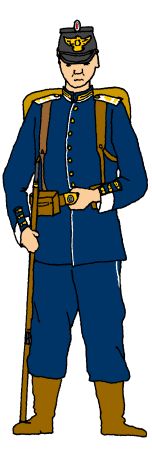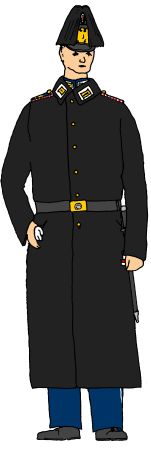|
Figure 1 is based on a
photograph of a Marine (or Seesoldat ) of the III. Seebataillon in
peacetime service
dress. He wears a black leather Jäger shako with an oval Imperial
white/black/white/red/white cockade and a brass imperial eagle
superimposed over a naval anchor on the front. Unlike Jägers though, the
Seebataillon wore neither state nor imperial cockades under the chinstrap
buttons.
The tunic was a version of the German army
M1842/95 Waffenrock infantry tunic in dark blue with a white standing collar, white Brandenburg
cuffs, white piping and gold double Litzen (see right). The white piping
also extended down the front and rear skirts. Buttons were plain brass.
Shoulder boards for other ranks were white, with a yellow imperial crown,
crossed anchors and battalion numeral (in this case III) in yellow. The
matching trousers are also dark blue piped in white.
He is armed with a Mauser Gewehr 98 and
carries M1895 ammunition pouches in brown leather as was standard for the
III. Seebataillon to match their tropical uniforms. Marching boots for the III.
Seebataillon were also in
matching brown leather. The belt buckle is the two metal standard other
ranks version with an imperial crown for Schutztruppe and Naval personnel
(see bottom right).
This uniform was not usually worn in action by
the Seebataillone but was the home uniform for the I. & II.
Seebataillone in Germany, and the winter peacetime service dress of the
III. Seebataillon in Tsingtao. It was also worn by the I. & II.
Seebataillone (with a grey/green cover in
the shako) in the first year fighting on the Western front in 1914-15 before
they were issued with M1910 field grey uniforms (see
Seebataillone on the Western Front
page). |
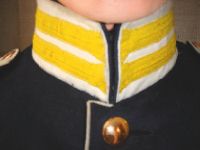
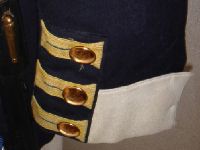
Details of the collar and cuffs
(See
Seebataillon
Blue Uniform Details Page)
Photo Copyright Doppler |
|
Figure 2 is based on a
photograph of a Marine of the Skutari Detachment taken either in
1913 or early 1914. He wears the same dark blue M1895 uniform as the
previous figure but seen from the rear, showing the scalloped piping
pattern on the rear shirts (see below right). Also notice the rear peak of the
Jäger
style shako. The only way in which this uniform differs from that of
the III. Seebataillon is in the battalion numeral on the shoulder
board (members of the Marie Detachment Skutari wore the numeral of
their parent battalion - either I or II- see right). Equipment and
boots for this Seesoldat are in blackened leather as was worn by the I.
and II. Seebataillone.
Although not clearly visible here the rifle
may be an Austro-Hungarian Mannlicher. The Skutari Detachment were
partially equipped by Austro-Hungary, some sources state that the Skutari
Detachment also wore items of Austro-Hungarian uniform such as the Austro-Hungarian
other ranks peaked cap with two small German cockades on the front in
place of the usual brass buttons. |
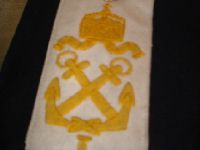
Details of the Shoulder Strap
(See
Seebataillon
Blue Uniform Details Page)
Photo Copyright Doppler |
|
Figure 3 is based on a
photograph of a Kaiser Wilhelm II in the uniform of the I. Seebataillon
taken in 1900 while inspecting the Marine Expeditionskorps before their
departure for the Boxer Rebellion. The Kaiser wears the uniform of a
senior officer. Officers' uniforms were privately tailored and differed
only from other ranks uniforms in the quality of the cut. The Kaiser of
course, would have the very best uniforms available. His collar is high
and has long extended Litzen in gold rather than yellow. As an officer
on parade he wears braided silver cords across his right chest. Wilhelm
suffered from a withered left arm and as such had uniforms personally
tailored with a slightly shorter left sleeve. He was very conscious of
his arm and usually hid it from cameras often resting on his sword as in
this illustration. His naval officer's belt is silver silk with black
and red threads (see right) and his rank insignia is shown on his
shoulder straps (see below right and
Officers Rank Insignia Page). The
Kaiser had his own rank insignia in the Seebataillon, it consisted of a
silver braided strap edged in gold with a brass Imperial crown above
crossed Field Marshall's batons in white metal with a brass "W"
monogram.
Kaiser Friedrich
Wilhelm Viktor Albrecht von Hohenzollern (1859-1941), King of Prussia
and Emperor of Germany. Wilhelm II acceded to throne after the short reign
of his father Kaiser Friedrich III in 1888. Germany was experiencing a
peak in national pride at the time. Recent victories against Denmark,
Austria-Hungary and France had united Germany and along with a boom in
industry and the acquisition of new colonies had made the new Empire into
a World Power. Wilhelm embraced all these advances especially in the
military. He took a keen interest in the army and build up of the navy,
even down to making personal notes on new uniforms being introduced for
the Schutztruppe. He proudly wore uniforms from many of his armed forces, including
those of the I. Seebataillon. It was in this Seebataillon uniform that he gave his
infamous "Hun" speech to the East Asian Expeditionary force before their
departure to China in 1900. Wilhelm's aggressive military tendencies also
encouraged the arms race and mobilisation that preceded the First World
War. In 1918 with Germany defeated and on the brink of revolution he abdicated his
throne and fled into exile in Holland, from whence he never returned.
|
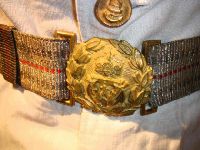
A Naval Officers belt buckle
(See
Seebataillon White Uniform Page)
Photo Copyright Damien Doppler
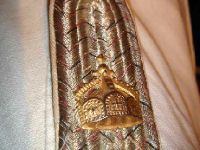
Seebataillon Officer's Shoulder Strap
(See
Seebataillon White Uniform Page)
Photo Copyright Doppler |
|
Figure 4 is based on a
photograph of a One Year Volunteer from the I. Seebataillon. He wears the M1867 other ranks black
greatcoat worn by the Seebataillone up to and during the First World War
although it had long been replaced by grey coats in the regular army and
Schutztruppe. It was single breasted with six plain brass buttons down the
front and two hip pockets. The rear was not piped with a small holding
belt and one central brass button. The shoulder straps were the same as on
the tunic (see above right) but in this case with twisted black/white/red
cord around the edges as the insignia of a One Year Volunteer.
Seebataillon other ranks wore white collar patches with double yellow
Litzen on the great coat. NCO ranks were distinguished by strips of braid
on the collar patch. Officers greatcoats were grey and double breasted,
with a blue collar (without Litzen) and white lining (see
Seebataillone on the Western Front
page). Winters in Tsingtao proved the need for greatcoats quite often.
The shako is worn with a black (red for
musicians) horsehair plume as worn on parade (see right). Underneath the
greatcoat he wears the M1895 blue tunic and matching trousers (white
trousers were worn on parade in Summer). His belt is in black leather as
worn by the I. and II. Seebataillone in Germany.
One Year Volunteers had a curious position
within the German armed forces. Whereas as most Germans were subject to
three years conscription in the regular armed forces followed by part
time participation in the the Reserve, Landwehr and Landsturm, a one year volunteer
could elect to serve only one year before going onto the reserves or
straight to officer training. Only the wealthy could choose to become a
one year volunteer for they had to pay for their own uniform, equipment
and rations. Because of this many one year volunteers' uniforms were tailor
made and of superior quality, their only other distinction being an edging
of black/white/red cord around the shoulder strap. One year volunteers
were added as surplus to the strength of a unit and as well as in the
regular army they also served in the Seebataillone and Schutztruppe. |

Two Seebataillon Shakos
The one on the left is completely
obscured by its parade plume
(See
Brussels Royal Army Museum Page)
Musée Royale de l'Armée Collection
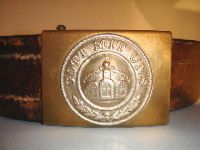
Naval Other Ranks Belt Buckle
(See
Belt Buckles Details Page)
Photo Copyright Doppler |
|
Figure 5 is based on a
photograph of an Officer of the II. Seebataillon, Major von
Lettow-Vorbeck wearing the officers frock coat ("Überrock"). The officers frock coat was worn
on "undress" occasions. It was a three quarter
length double breasted dark blue coat coat with six buttons down
either side, the front and deep cuffs were both piped in white as
were the rear skirts (see below right). The standing collar was
white piped in blue along the upper edge. It had buttoned hip
pockets and a slit behind the left pocket for the sword hanging.
Officer's shoulder straps were worn as on the tunic (see above
right) and von Lettow-Vorbeck has a medal ribbon in his second
buttonhole. With the
frock coat Lettow-Vorbeck wears a blue officer's peaked field cap
with white hatband and piping and a small Imperial cockade (see
right).
Paul Emil von
Lettow-Vorbeck (1870-1964) initially gained his commission in the 4th
Prussian Foot Guards (4. Garderegiment zu Fuss), before serving on the staff of Lothar von Trotha in both the Boxer
and Herero Rebellions in China and German South West
Africa respectively. It was while in South West Africa that he learned
useful lessons in guerrilla warfare from the Herero. From 1909-13 he commanded the II.
Seebataillon based
at Wilhelmshaven. In early 1914 he was considered for the post of commander of the
Schutztruppe for Cameroon but was eventually appointed as commander for
German East Africa. He gained fame in the First World War as the only
undefeated German general of the war, his East African Schutztruppe
fighting on throughout the four years of war and only laying down
their arms after hearing of the armistice in Europe in November 1918.
After the war he served in the Freikorps, Reichswehr and was active in
politics, serving in the Weimar Reichstag. During the 1930's he was offered the position of German Ambassador to
Great Britain by Adolf Hitler but turned it down because of his dislike of the National
Socialists.
|
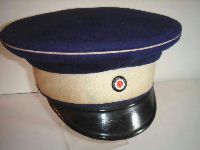
Seebataillon Peaked Cap
(See
Field Cap Details Page)
Photo Copyright Doppler
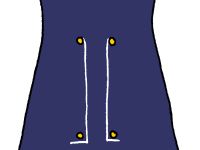
Rear of Frock Coat Piping Details |
|
|
|
